BAE System Bundle
Who Buys from BAE Systems?
In an era of escalating global defense spending, understanding the BAE System SWOT Analysis customer demographics and target market is crucial. With the defense industry projected to reach $2.68 trillion in 2025, BAE Systems, a global leader, must precisely identify and cater to its clientele's needs. This analysis dives deep into the company's customer base and market dynamics.
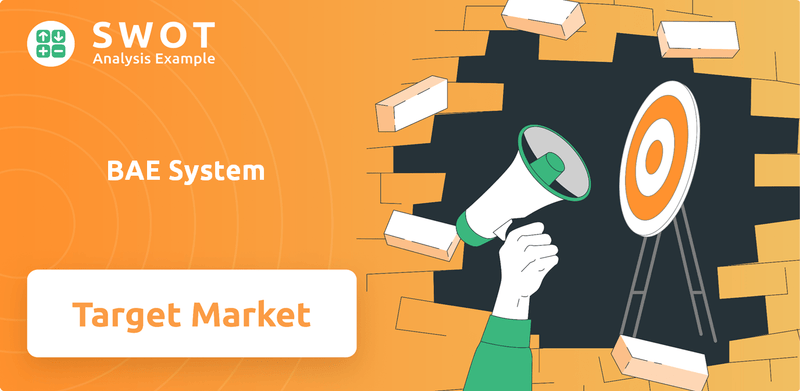
This exploration of BAE Systems' customer segmentation analysis will reveal the demographic profile of BAE Systems clients, including the geographic distribution of BAE Systems customers and their specific needs. The company's strategic adaptation to serve its defense industry customers is key to maintaining its market share and navigating the complexities of the aerospace sector. Discover how BAE Systems identifies its target market and its customer acquisition strategies.
Who Are BAE System’s Main Customers?
Understanding the primary customer segments is crucial for analyzing the business operations of BAE Systems. The company operates mainly in the Business-to-Government (B2G) and Business-to-Business (B2B) models, focusing on serving governments, armed forces, and commercial customers worldwide. The core of its customer base consists of national defense departments, their branches (air, land, and naval forces), and intelligence and security agencies.
While specific demographic breakdowns like age or income levels aren't directly applicable, the key criteria for segmentation include national defense budgets, geopolitical priorities, technological sophistication, and specific operational requirements. The company's success is heavily influenced by these factors, which shape its strategic priorities and customer engagement. This customer focus highlights the importance of understanding the defense industry's dynamics.
The primary focus of BAE Systems is on defense and security. This focus is reflected in its customer base, which is primarily composed of governmental entities and related organizations. Analyzing the customer demographics and target market is essential for investors and strategists alike. For more insights into the company's financial strategies, consider exploring the Revenue Streams & Business Model of BAE System.
The United States accounted for 47.7% of net sales in 2024, followed by the United Kingdom at 26.8% and Saudi Arabia at 11%. These figures highlight the significant reliance on government contracts in these key regions, demonstrating the geographic concentration of BAE Systems' customer base.
Customers demand highly specialized and technologically advanced solutions. BAE Systems focuses on areas like electronic warfare, autonomy, and space solutions. The company's focus on innovation and advanced technologies reflects the evolving needs of its target market.
Ongoing conflicts and geopolitical tensions, like the Russia-Ukraine war, have increased defense spending. This has influenced BAE Systems' strategic priorities and customer engagement, leading to increased demand for modern defense equipment. The company's strategic focus is adapting to these global shifts.
BAE Systems focuses on long procurement cycles and stringent regulatory requirements. Its U.S. subsidiary, BAE Systems Inc., is a major supplier to the U.S. Department of Defense. The company's customer acquisition strategies involve building strong relationships with governmental entities.
BAE Systems' key customer segments are primarily national defense departments, armed forces (air, land, and naval forces), and intelligence and security agencies. These segments are characterized by long procurement cycles and stringent regulatory requirements.
- National Defense Departments
- Armed Forces (Air, Land, Naval)
- Intelligence and Security Agencies
- Commercial Customers (in specific sectors)
BAE System SWOT Analysis
- Complete SWOT Breakdown
- Fully Customizable
- Editable in Excel & Word
- Professional Formatting
- Investor-Ready Format
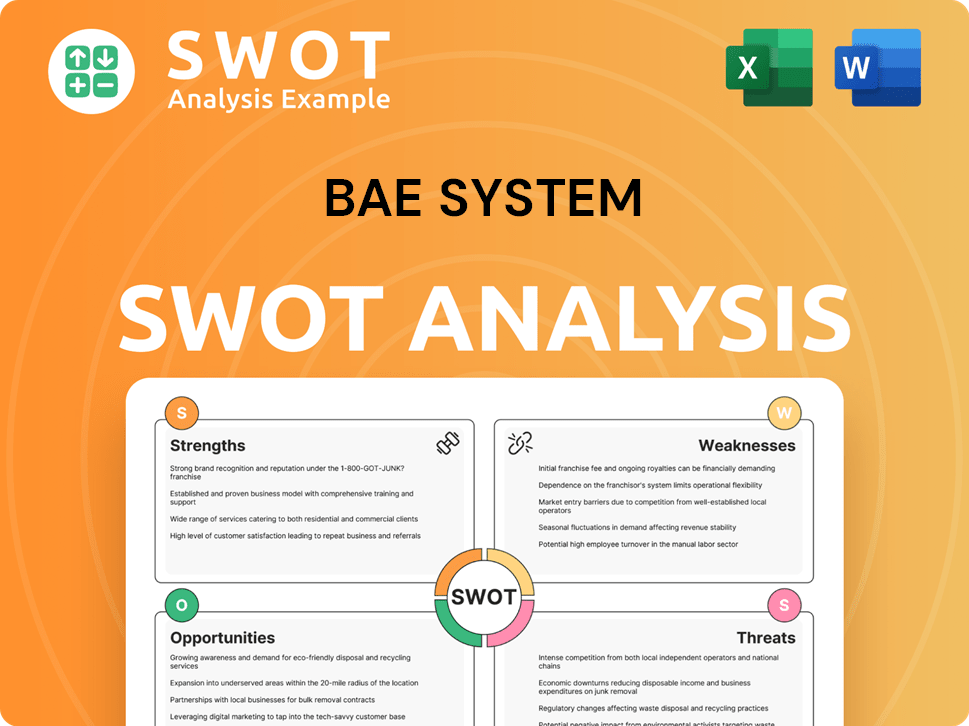
What Do BAE System’s Customers Want?
The core of BAE Systems' business revolves around understanding and fulfilling the needs of its customers, primarily governments and armed forces. These customers are driven by critical requirements related to national security, defense capabilities, and technological superiority. The company's success hinges on its ability to provide solutions that meet these demanding needs, ensuring operational effectiveness and strategic advantage.
BAE Systems' target market is characterized by long-term strategic planning and rigorous evaluation processes. This involves a comprehensive assessment of factors beyond initial cost, including lifecycle support, maintenance, and future upgradeability. Decision-making also considers geopolitical implications, emphasizing the need for reliable and interoperable solutions.
The company's focus on innovation and advanced technology, such as artificial intelligence and cybersecurity, is driven by the evolving threats and the pursuit of multi-domain dominance. BAE Systems continually invests in research and development to meet these demands, ensuring it remains at the forefront of the defense industry.
BAE Systems' customers need solutions that enhance national security and defense capabilities. They require advanced technology and reliable performance in challenging environments. The demand for cutting-edge solutions is driven by the need to address evolving threats.
Purchasing decisions are based on long-term strategic planning and rigorous evaluation. Customers prioritize reliability, interoperability, and advanced performance. Lifecycle support, maintenance, and future upgradeability are key considerations.
The imperative to protect national interests and ensure troop safety drives customer choices. Maintaining a strategic advantage in a complex global security landscape is also a key factor. Customers seek solutions that provide a technological edge.
Customers need robust and dependable equipment that performs effectively in diverse environments. Solutions must integrate seamlessly with existing defense infrastructures. Real-time, actionable data and secure communication are essential.
The pursuit of next-generation capabilities, such as AI and cybersecurity, is a key driver. Customers aim to address evolving threats and achieve multi-domain dominance. They seek solutions that offer a technological advantage.
BAE Systems addresses the need for real-time data in contested environments. It focuses on modernizing legacy systems and ensuring secure communication. The company collaborates to develop data-driven solutions for enhanced operational effectiveness.
BAE Systems' customer base, which includes governments and armed forces, is highly specialized, with specific needs and preferences that drive its product development and service offerings. The company's ability to understand and meet these requirements is fundamental to its success. For example, the company's involvement in the Lockheed Martin F-35 Lightning II and Eurofighter Typhoon programs demonstrates its commitment to delivering advanced capabilities tailored to specific national requirements. Further insights into the financial aspects of the company can be found in the article about Owners & Shareholders of BAE System.
BAE Systems' key customer segments include various branches of the military and government agencies. These customers are spread across different geographic regions, with a significant presence in the United States and the United Kingdom.
- Governments: National defense departments and ministries.
- Armed Forces: Military branches (Army, Navy, Air Force, Marines).
- Aerospace Sector: Companies involved in aircraft manufacturing and maintenance.
- Intelligence Agencies: Organizations requiring advanced surveillance and security solutions.
- International Customers: Governments and armed forces worldwide.
BAE System PESTLE Analysis
- Covers All 6 PESTLE Categories
- No Research Needed – Save Hours of Work
- Built by Experts, Trusted by Consultants
- Instant Download, Ready to Use
- 100% Editable, Fully Customizable
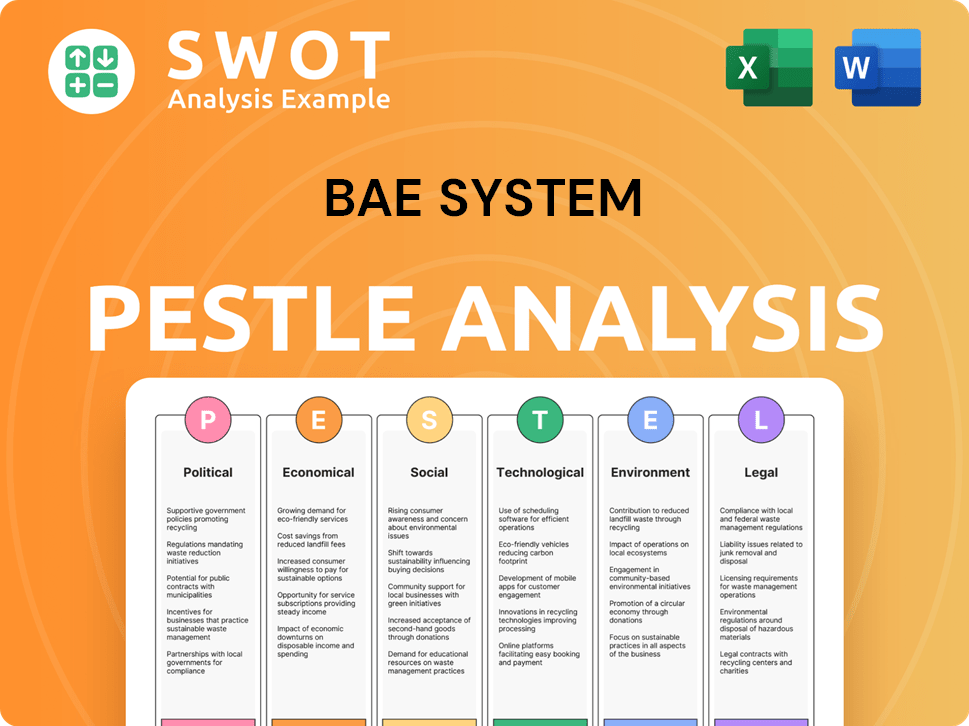
Where does BAE System operate?
The geographical market presence of BAE Systems is a key factor in its strategic success, reflecting its focus on regions with significant defense spending and strategic importance. The company's customer base is spread across several key regions, with the United States being its largest market. This diversified approach allows the company to capitalize on global defense trends and maintain a strong financial position.
The company's customer demographics vary across these regions, influenced by each country's defense priorities and budgets. This includes the United Kingdom, Saudi Arabia, Australia, Europe, and Canada. BAE Systems tailors its offerings and marketing strategies to meet the specific needs of each market, ensuring its relevance and competitiveness in the global defense industry.
BAE Systems's strategic expansions, such as its involvement in the Global Combat Air Programme (GCAP), further solidify its geographic presence. These initiatives, coupled with investments in new facilities, highlight the company's commitment to enhancing its capacity and modernizing its systems. This strategic positioning enables the company to benefit from rising defense spending worldwide.
The United States is the largest market for BAE Systems, accounting for 47.7% of its net sales in 2024. This strong foothold demonstrates the company's brand recognition within the U.S. defense sector. The U.S. defense market is characterized by a significant demand for advanced unmanned aerial vehicles and continuous technological innovation.
The United Kingdom is a key market for BAE Systems, contributing 26.8% of net sales. BAE Systems is the largest defense contractor in the UK and a critical contributor to national security. The company's presence in the UK is vital for supporting national defense priorities.
Saudi Arabia is another major market for BAE Systems, representing 11% of net sales. BAE Systems is a key supplier to various branches of the Royal Saudi Armed Forces. This market highlights the company's global reach and its ability to meet the defense needs of key allies.
Other significant markets include Australia (4.4%), Europe (6.6%), and Canada (0.7%). These markets showcase BAE Systems' diversified portfolio and its ability to capitalize on rising defense spending in various regions. The company's presence in these areas supports its long-term growth strategy.
The company's strategic expansions, such as its involvement in the Global Combat Air Programme (GCAP) with Italy and Japan, are expected to contribute significantly to economic growth. This program is expected to contribute £37 billion to the UK economy and support 16,000 jobs annually over the next decade. These initiatives, coupled with investments in new facilities, highlight the company's commitment to enhancing its capacity and modernizing its systems. The geographic distribution of sales and growth highlights the company's diversified portfolio and strategic positioning to benefit from rising defense spending in various regions, including Asia-Pacific and the Middle East.
BAE System Business Model Canvas
- Complete 9-Block Business Model Canvas
- Effortlessly Communicate Your Business Strategy
- Investor-Ready BMC Format
- 100% Editable and Customizable
- Clear and Structured Layout
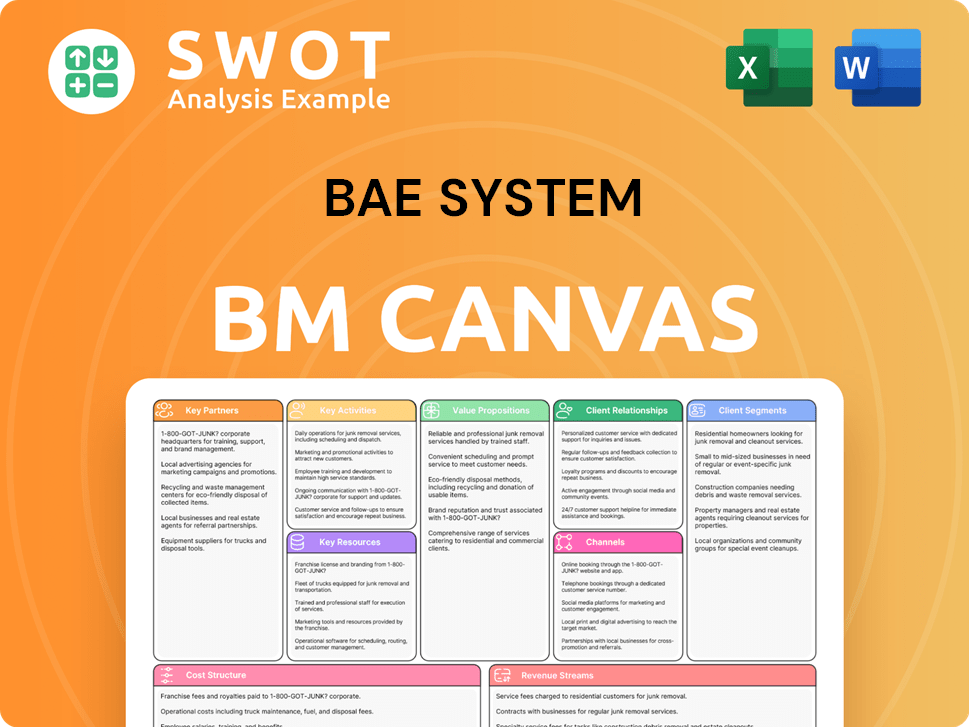
How Does BAE System Win & Keep Customers?
Customer acquisition and retention strategies at BAE Systems are primarily geared towards long-term engagements with governments and strategic partners in the defense and aerospace sectors. Unlike businesses that focus on consumer markets, BAE Systems’ approach centers on building and maintaining relationships with national governments and armed forces. Their success hinges on their reputation for technological advancement, operational excellence, and reliable delivery.
Key strategies for acquiring customers include direct interactions with defense ministries and agencies, competitive bidding for major defense programs, and showcasing capabilities at industry events. Recent contract wins demonstrate these efforts, such as the $356.7 million contract modification from the U.S. Army in March 2025, and an $85 million production contract from the U.S. Navy in January 2025. They also secured a $2.5 billion deal for CV90 combat vehicles with Sweden and Denmark in 2024. This highlights their focus on securing long-term, high-value contracts.
Retention strategies emphasize consistent performance, comprehensive after-sales service, and continuous innovation. BAE Systems invests heavily in technology, facilities, and its global workforce. Their commitment to operational excellence and contracting discipline is crucial for customer loyalty. Collaborative research and development, like the partnership with Aerospike, further enhances their offerings. The company's impressive order backlog, which reached a record £77.8 billion, provides substantial revenue visibility and supports long-term growth. To learn more about their growth strategy, consider reading this article: Growth Strategy of BAE System.
BAE Systems uses direct engagement with defense ministries and agencies as a primary acquisition strategy. They also participate in competitive bidding for large-scale defense programs to secure contracts. Showcasing their capabilities at industry exhibitions and defense expos is another crucial part of their customer acquisition efforts.
The primary BAE Systems customer base includes national governments and their armed forces. They also work with defense ministries and agencies across the globe. Their focus is on long-term contracts within the defense and aerospace sectors.
Retention strategies focus on delivering consistent performance and providing comprehensive after-sales service. Continuous innovation to meet evolving customer needs is also crucial. Long-term investments in technology and workforce ensure the ability to deliver critical capabilities.
Increased focus on digital technologies, AI, and cybersecurity impacts how BAE Systems targets and serves its customers. These advancements allow them to offer more technologically advanced and integrated systems. This shift is a key part of their evolving strategy.
BAE Systems market analysis involves understanding the needs and preferences of military customers globally. They focus on providing cutting-edge defense solutions. Their customer relationship management is critical for maintaining strong ties.
- BAE Systems target market is primarily government entities and armed forces.
- They aim to meet the specific needs of military personnel through advanced technology.
- Demographic profile of BAE Systems clients includes defense ministries and agencies.
- BAE Systems' target market in the aerospace sector includes various government and defense organizations.
BAE System Porter's Five Forces Analysis
- Covers All 5 Competitive Forces in Detail
- Structured for Consultants, Students, and Founders
- 100% Editable in Microsoft Word & Excel
- Instant Digital Download – Use Immediately
- Compatible with Mac & PC – Fully Unlocked
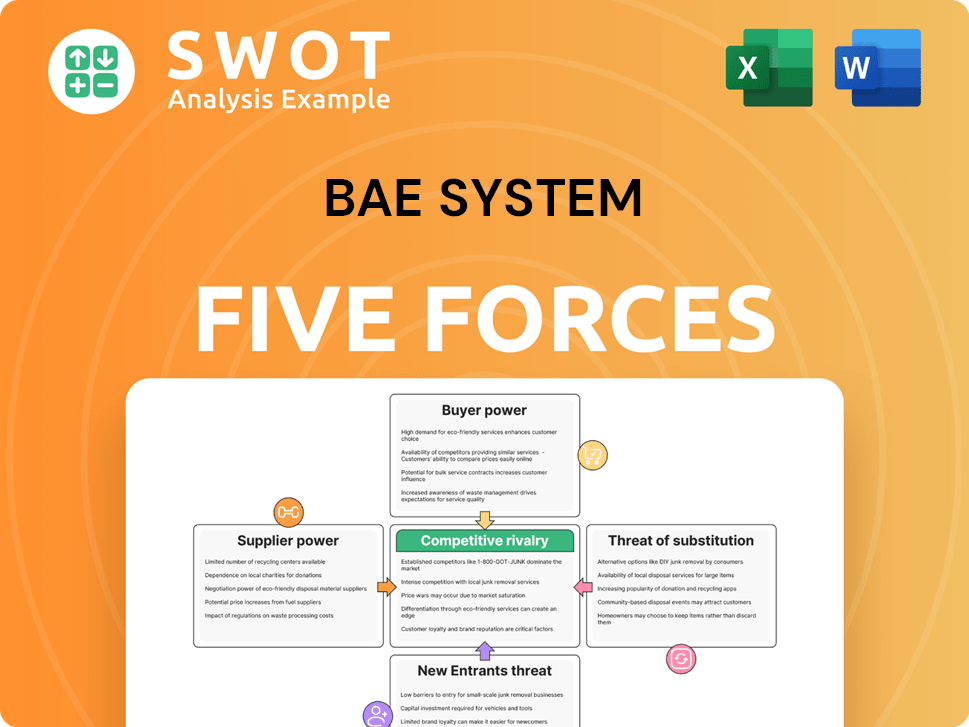
Related Blogs
- What are Mission Vision & Core Values of BAE System Company?
- What is Competitive Landscape of BAE System Company?
- What is Growth Strategy and Future Prospects of BAE System Company?
- How Does BAE System Company Work?
- What is Sales and Marketing Strategy of BAE System Company?
- What is Brief History of BAE System Company?
- Who Owns BAE System Company?
Disclaimer
All information, articles, and product details provided on this website are for general informational and educational purposes only. We do not claim any ownership over, nor do we intend to infringe upon, any trademarks, copyrights, logos, brand names, or other intellectual property mentioned or depicted on this site. Such intellectual property remains the property of its respective owners, and any references here are made solely for identification or informational purposes, without implying any affiliation, endorsement, or partnership.
We make no representations or warranties, express or implied, regarding the accuracy, completeness, or suitability of any content or products presented. Nothing on this website should be construed as legal, tax, investment, financial, medical, or other professional advice. In addition, no part of this site—including articles or product references—constitutes a solicitation, recommendation, endorsement, advertisement, or offer to buy or sell any securities, franchises, or other financial instruments, particularly in jurisdictions where such activity would be unlawful.
All content is of a general nature and may not address the specific circumstances of any individual or entity. It is not a substitute for professional advice or services. Any actions you take based on the information provided here are strictly at your own risk. You accept full responsibility for any decisions or outcomes arising from your use of this website and agree to release us from any liability in connection with your use of, or reliance upon, the content or products found herein.